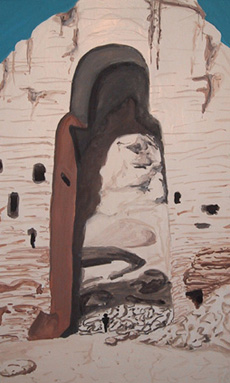AFGHANISTAN | NEPAL
The Purpose of This Section is:
- To provide students and scholars with access to visual materials that have been lost or stolen from their place of origin or museum collections.
- To help prevent the perpetuation of art theft throughout Asia by providing collectors, art dealers, and museum curators with visual references to works of art that are know or believed to have been stolen.
- To increase awareness about the growing problem of art theft throughout Asia.
The countries currently covered within this section of our web site are Afghanistan and Nepal. Because of the current political state of Afghanistan and the looting of the Kabul Museum, all Huntington Archive photographs taken in 1970 at the Kabul Museum (162 black and white) have been included in this section, whether or not they actually have been stolen, damaged, or lost. Images included in the Nepal portion comprise only a fraction of works that have been lost, stolen, or destroyed from this part of the Himalayan region.
Unless otherwise indicated, the photographs contained in this section of our web site were taken by John C. and Susan L. Huntington. In the case of Nepal, a majority of the photographs were taken by Lain Singh Bangdel. All of the images within these pages are copyrighted. Please feel free to view them from this site, however, none of these images should be downloaded or duplicated in any way without the permission of the copyright holders.
A special thanks goes to Joanna Williams and John C. Huntington for bringing the issue of the Kabul Museum and the future of its works at the 1996 meeting of the American Council of Southern Asian Art in Minneapolis, MN.
Please contact us if you have suggestions or photographs of your own that you would like to contribute to this project.
AFGHANISTAN
Bamiyan
Includes: An Introduction to Bamiyan, Maps, Brihad (Colossal) Buddhas, and Paintings contained in the surrounding niches.
The Bamiyan section was established through a generous grant from the National Endowment for the Humanities (NEH) Division of Preservation and Access. It is part of a larger NEH project that supports the "Cataloguing and Digitization of Photographic Materials Related to Buddhist Art" in The Huntington Archive.
Works from the Kabul Museum
Because of the nature of this section, the visual resources have been organized according to material, rather than subject matter. The text included with the images are based on field notes taken by John and Susan Huntington in 1970 and primarily represent museum attributions that were copied directly from information provided on the museum labels. When attributions have been changed by the editor, usually because a different interpretation has already been widely accepted by the scholarly community, a note referring to the museum attribution has been included at the bottom.
All of the black and white images in the Afghanistan site were scanned and corrected by Chaya Chandrasekhar and Cathleen Cummings. John Huntington and Zach Sophia prepared the color images.
NEPAL
The visual resources found in this section have been organized according to subject matter. The accompanying data reflects the research and scholarly efforts of the late Lain S. Bangdel, who was Nepal's leading art historian. The actual or approximate (when not recorded) height of the images is given in inches. The dates indicating when the images were stolen, removed, or damaged are based upon information provided by local residents and police records. Except as noted, all of the images were photographed by Lain S. Bangdel, and published in his book, Stolen Images of Nepal.
*The Huntington Archive would like to express our deepest gratitude to Mr. Bangdel for making his photographs and research materials available to the Archive and the world community. It is our sincerest hope that his generosity and this web site might contribute in some small way to the preservation of Nepal's history and culture.


